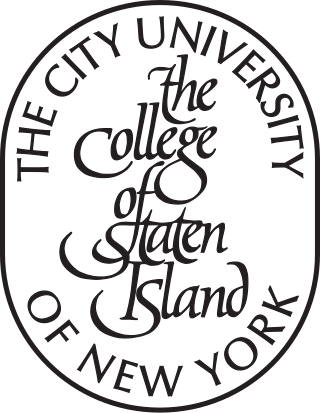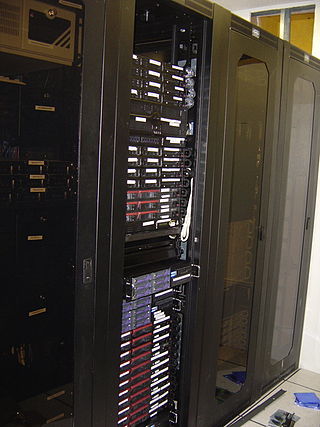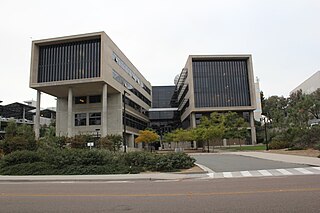Related Research Articles

A supercomputer is a computer with a high level of performance as compared to a general-purpose computer. The performance of a supercomputer is commonly measured in floating-point operations per second (FLOPS) instead of million instructions per second (MIPS). Since 2017, there have existed supercomputers which can perform over 1017 FLOPS (a hundred quadrillion FLOPS, 100 petaFLOPS or 100 PFLOPS).
Sheridan College Institute of Technology and Advanced Learning is a public polytechnic institute of technology located in the west-Greater Toronto Area in Ontario, Canada.

The College of Staten Island (CSI) is a public university in Staten Island, New York. It is one of the 11 four-year senior colleges within the City University of New York system. Programs in the liberal arts and sciences and professional studies lead to bachelor's and associate degrees. The master's degree is awarded in 13 professional and liberal arts and sciences fields of study. A clinical doctorate is awarded by the department of physical therapy. The college participates in doctoral programs of the CUNY Graduate Center in biochemistry, biology, chemistry, computer science, nursing, physics, and psychology.

A server farm or server cluster is a collection of computer servers, usually maintained by an organization to supply server functionality far beyond the capability of a single machine. They often consist of thousands of computers which require a large amount of power to run and to keep cool. At the optimum performance level, a server farm has enormous financial and environmental costs. They often include backup servers that can take over the functions of primary servers that may fail. Server farms are typically collocated with the network switches and/or routers that enable communication between different parts of the cluster and the cluster's users. Server "farmers" typically mount computers, routers, power supplies and related electronics on 19-inch racks in a server room or data center.

The San Diego Supercomputer Center (SDSC) is an organized research unit of the University of California, San Diego (UCSD). SDSC is located at the UCSD campus' Eleanor Roosevelt College east end, immediately north the Hopkins Parking Structure.

High-performance computing (HPC) uses supercomputers and computer clusters to solve advanced computation problems.
Jonathan Michael Borwein was a Scottish mathematician who held an appointment as Laureate Professor of mathematics at the University of Newcastle, Australia. He was a close associate of David H. Bailey, and they have been prominent public advocates of experimental mathematics.
Ian Tremere Foster is a New Zealand-American computer scientist. He is a distinguished fellow, senior scientist, and director of the Data Science and Learning division at Argonne National Laboratory, and a professor in the department of computer science at the University of Chicago.
The Corporation for Education Network Initiatives in California is a nonprofit corporation formed in 1997 to provide high-performance, high-bandwidth networking services to California universities and research institutions. Through this corporation, representatives from all of California's K-20 public education combine their networking resources toward the operation, deployment, and maintenance of the California Research and Education Network, or CalREN. Today, CalREN operates over 8,000 miles of fiber optic cable and serves more than 20 million users.

EPCC, formerly the Edinburgh Parallel Computing Centre, is a supercomputing centre based at the University of Edinburgh. Since its foundation in 1990, its stated mission has been to accelerate the effective exploitation of novel computing throughout industry, academia and commerce.
The Texas Advanced Computing Center (TACC) at the University of Texas at Austin, United States, is an advanced computing research center that provides comprehensive advanced computing resources and support services to researchers in Texas and across the USA. The mission of TACC is to enable discoveries that advance science and society through the application of advanced computing technologies. Specializing in high performance computing, scientific visualization, data analysis & storage systems, software, research & development and portal interfaces, TACC deploys and operates advanced computational infrastructure to enable computational research activities of faculty, staff, and students of UT Austin. TACC also provides consulting, technical documentation, and training to support researchers who use these resources. TACC staff members conduct research and development in applications and algorithms, computing systems design/architecture, and programming tools and environments.

The National Energy Research Scientific Computing Center (NERSC), is a high-performance computing (supercomputer) National User Facility operated by Lawrence Berkeley National Laboratory for the United States Department of Energy Office of Science. As the mission computing center for the Office of Science, NERSC houses high performance computing and data systems used by 9,000 scientists at national laboratories and universities around the country. NERSC's newest and largest supercomputer is Perlmutter, which debuted in 2021 ranked 5th on the TOP500 list of world's fastest supercomputers.
The terms design computing and other relevant terms including design and computation and computational design refer to the study and practice of design activities through the application and development of novel ideas and techniques in computing. One of the early groups to coin this term was the Key Centre of Design Computing and Cognition at the University of Sydney in Australia, which for nearly fifty years pioneered the research, teaching, and consulting of design and computational technologies. This group organised the academic conference series "Artificial Intelligence in Design (AID)" published by Springer during that period. AID was later renamed "Design Computing and Cognition (DCC)" and is currently a leading biannual conference in the field. Other notable groups in this area are the Design and Computation group at Massachusetts Institute of Technology's School of Architecture + Planning and the Computational Design group at Georgia Tech.

CANARIE is the not-for-profit organisation which operates the national backbone network of Canada's national research and education network (NREN). The organisation receives the majority of its funding from the Government of Canada. It supports the development of research software tools; provides cloud resources for startups and small businesses; provides access and identity management services; and supports the development of policies, infrastructure and tools for research data management.
Established in 2003 as a shared service to provide advanced computing support and services to the Atlantic Canadian research community, ACENET was a consortium of five universities. Since then, its membership has grown and so has its mission. ACENET has 14 Atlantic university and community college members, and provides access to advanced computing infrastructure, technical support, and digital skills development to academic researchers and their students at any post-secondary institution in the region, as well as government departments and industry.

A computer cluster is a set of computers that work together so that they can be viewed as a single system. Unlike grid computers, computer clusters have each node set to perform the same task, controlled and scheduled by software.

Fabric computing or unified computing involves constructing a computing fabric consisting of interconnected nodes that look like a weave or a fabric when seen collectively from a distance.

Applied mathematics is the application of mathematical methods by different fields such as physics, engineering, medicine, biology, finance, business, computer science, and industry. Thus, applied mathematics is a combination of mathematical science and specialized knowledge. The term "applied mathematics" also describes the professional specialty in which mathematicians work on practical problems by formulating and studying mathematical models.

Cybera is a not-for-profit corporation responsible for the operation of Alberta's Optical Regional Advanced Network. This network, known as CyberaNet, connects Alberta's research universities, colleges, K-12 schools, not-for-profits, and business incubators to one another and to the global grid of research and education networks using optical fibre. Cybera is funded by grants and its membership. The head office is located in the University of Calgary Research Park, with an additional office in downtown Edmonton.
SHARCNET is a consortium of universities in Ontario, Canada, that aggregate funding to purchase supercomputer systems, which are shared among the members to perform research, rather than individually purchasing smaller systems at each university. It was formed to allow members access to larger, faster, and more modern computer resources than they would otherwise be able to afford, and to retain researchers at their organizations. SHARCNET is part of the larger Compute Canada umbrella. As of June 2017, the fastest computer at SHARCNET according to the Top 500 list is Graham, which entered the list as the 95th fastest computer in the world with a High Performance Linpack result of 1,228 TeraFLOPS.